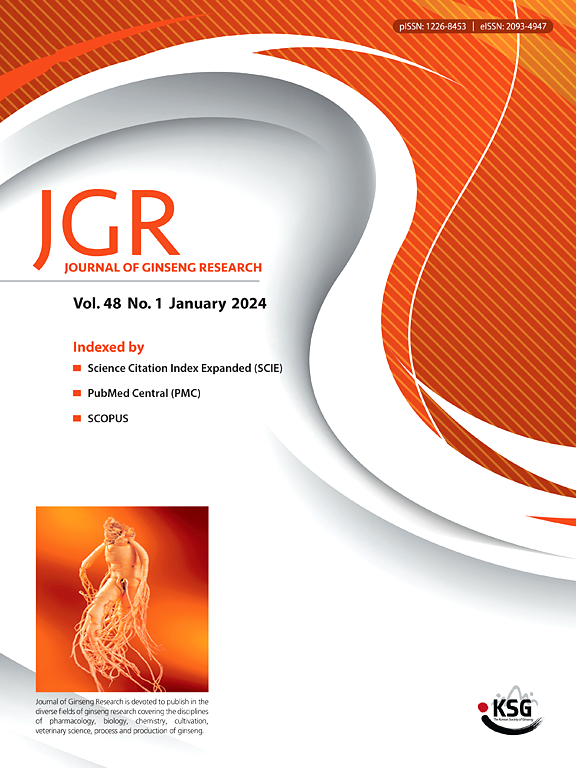人参皂苷Rg1通过TXNIP/NLRP3通路调节的线粒体自噬改善缺氧诱导的肺血管内皮功能障碍。
IF 6.8
2区 医学
Q1 CHEMISTRY, MEDICINAL
引用次数: 0
摘要
背景:血管内皮功能障碍(VED)是肺动脉高压(PAH)的主要致病事件之一。先前的研究表明人参皂苷Rg1 (Rg1)可以改善PAH,但Rg1在缺氧诱导的PAH中影响肺部VED的机制尚不清楚。方法:通过网络药理学、分子对接等实验,探讨Rg1影响PAH的机制。通过缺氧联合血管内皮生长因子(VEGFR)抑制剂su5416 (SuHx)建立PAH小鼠模型,通过缺氧建立细胞模型。检测Rg1在VED、氧化应激、炎症、线粒体自噬以及TXNIP和NLRP3表达中的功能。结果:在缺氧诱导的VED中,观察到氧化应激、炎症和线粒体自噬的进行性加重,并与体内和体外TXNIP和NLRP3表达升高有关。Rg1改善缺氧诱导的内皮依赖性血管舒张功能受损,增加一氧化氮(NO)和内皮NO合成酶(eNOS)表达。Rg1、SRI37330 (TXNIP抑制剂)、MCC950 (NLRP3抑制剂)和Liensinine(线粒体自噬抑制剂)通过降低小鼠和细胞中TXNIP和NLRP3的表达来减轻氧化应激、炎症和线粒体自噬。此外,SB203580(一种线粒体自噬激动剂)与Rg1联合使用可破坏Rg1对缺氧诱导的肺动脉和人肺动脉内皮细胞(HPAECs)的保护作用。结论:Rg1通过TXNIP/NLRP3通路调节氧化应激、炎症和线粒体自噬,改善缺氧诱导的肺血管内皮功能障碍。本文章由计算机程序翻译,如有差异,请以英文原文为准。

Ginsenoside Rg1 improves hypoxia-induced pulmonary vascular endothelial dysfunction through TXNIP/NLRP3 pathway-modulated mitophagy
Background
Vascular endothelial dysfunction (VED) is one of the main pathogenic events in pulmonary arterial hypertension (PAH). Previous studies have demonstrated that the ginsenoside Rg1 (Rg1) can ameliorate PAH, but the mechanism by which Rg1 affects pulmonary VED in hypoxia-induced PAH remains unclear.
Methods
Network pharmacology, molecular docking and other experiments were used to explore the mechanisms by which Rg1 affects PAH. A PAH mouse model was established via hypoxia combined with the vascular endothelial growth factor (VEGFR) inhibitor su5416 (SuHx), and a cell model was established via hypoxia. The functions of Rg1 in VED, oxidative stress, inflammation, mitophagy, and TXNIP and NLRP3 expression were examined.
Results
In hypoxia-induced VED, progressive exacerbation of oxidative stress, inflammation, and mitophagy were observed, and were associated with elevated TXNIP and NLRP3 expression in vivo and in vitro. Rg1 improved hypoxia-induced impaired endothelium-dependent vasodilation and increased nitric oxide (NO) and endothelial NO synthase (eNOS) expression. Rg1, SRI37330 (a TXNIP inhibitor), MCC950 (an NLRP3 inhibitor), and Liensinine (a mitophagy inhibitor) attenuated oxidative stress, inflammation, and mitophagy by reducing the expression of TXNIP and NLRP3 in mice and cells. Furthermore, the combination of SB203580 (a mitophagy agonist) with Rg1 disrupted the protective effect of Rg1 on hypoxia-induced pulmonary artery and human pulmonary artery endothelial cells (HPAECs).
Conclusion
Rg1 improves hypoxia-induced pulmonary vascular endothelial dysfunction through TXNIP/NLRP3 pathway-modulated oxidative stress, inflammation and mitophagy.
求助全文
通过发布文献求助,成功后即可免费获取论文全文。
去求助
来源期刊

Journal of Ginseng Research
CHEMISTRY, MEDICINAL-INTEGRATIVE & COMPLEMENTARY MEDICINE
CiteScore
11.40
自引率
9.50%
发文量
111
审稿时长
6-12 weeks
期刊介绍:
Journal of Ginseng Research (JGR) is an official, open access journal of the Korean Society of Ginseng and is the only international journal publishing scholarly reports on ginseng research in the world. The journal is a bimonthly peer-reviewed publication featuring high-quality studies related to basic, pre-clinical, and clinical researches on ginseng to reflect recent progresses in ginseng research.
JGR publishes papers, either experimental or theoretical, that advance our understanding of ginseng science, including plant sciences, biology, chemistry, pharmacology, toxicology, pharmacokinetics, veterinary medicine, biochemistry, manufacture, and clinical study of ginseng since 1976. It also includes the new paradigm of integrative research, covering alternative medicinal approaches. Article types considered for publication include review articles, original research articles, and brief reports.
JGR helps researchers to understand mechanisms for traditional efficacy of ginseng and to put their clinical evidence together. It provides balanced information on basic science and clinical applications to researchers, manufacturers, practitioners, teachers, scholars, and medical doctors.
 求助内容:
求助内容: 应助结果提醒方式:
应助结果提醒方式:


